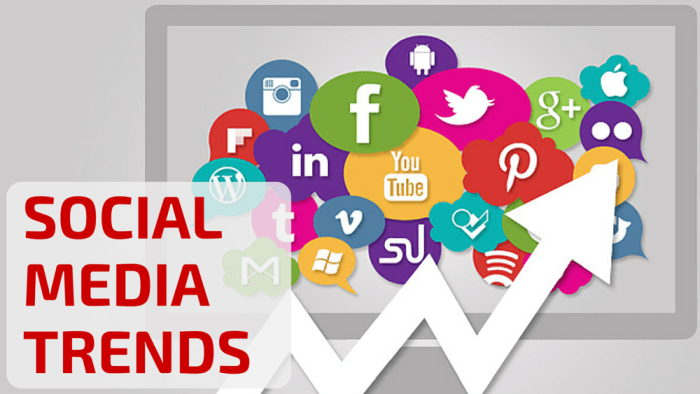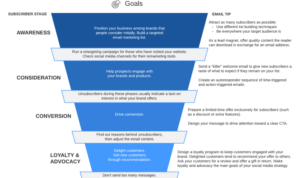Social Media Trends are all the rage right now, from viral content to cutting-edge technologies. Get ready to dive into the fascinating world of what’s hot and happening on social media!
In this exploration, we’ll uncover the impact of different trends, the role of influencers, and the exciting future of social media. So, buckle up and let’s ride this wave of digital revolution together!
Overview of Social Media Trends

Social media trends refer to the popular topics, hashtags, challenges, or formats that dominate various social media platforms at a given time. These trends can range from viral dances to important social movements, shaping the conversations and interactions online.
Monitoring social media trends is crucial for businesses to stay relevant and engage with their target audience effectively. By keeping up with what is popular and resonating with users, companies can tailor their content, marketing strategies, and products/services to align with current trends, ultimately increasing brand visibility and customer engagement.
Examples of Recent Popular Social Media Trends
- The rise of TikTok challenges such as the “Renegade” dance or “Savage” challenge, which have gained massive popularity among users of all ages.
- The #BlackLivesMatter movement, which started on social media platforms and sparked important discussions about racial injustice and equality worldwide.
- The use of Instagram Reels, a new feature that allows users to create short, engaging videos similar to TikTok, has quickly gained traction among influencers and brands.
Types of Social Media Trends
In the ever-evolving landscape of social media, trends play a crucial role in shaping user engagement. These trends can be categorized into various types, including content, platform, and design trends. Let’s explore each category and how they impact user engagement.
Content Trends
Content trends refer to the type of posts, videos, or articles that gain popularity on social media platforms. These trends often revolve around current events, challenges, or viral content. For example, the “Ice Bucket Challenge” was a content trend that went viral on social media, raising awareness for ALS. Such trends can significantly impact user engagement by encouraging users to participate, share, and interact with the content.
Platform Trends, Social Media Trends
Platform trends involve the emergence of new social media platforms or the evolution of existing ones. For instance, the rise of TikTok as a popular platform for short-form videos has influenced user behavior and engagement. Users are drawn to platforms that offer unique features or a different user experience, impacting how they interact with content and engage with others.
Design Trends
Design trends encompass the visual elements and aesthetics of social media posts and profiles. These trends can include themes, color schemes, and graphic styles that resonate with users. For example, the use of minimalist design and pastel colors has been a prevalent trend on Instagram, influencing how users engage with posts and profiles. Design trends can capture users’ attention, evoke emotions, and enhance the overall user experience.
Emerging Technologies in Social Media: Social Media Trends

As social media continues to evolve, new technologies are playing a significant role in shaping the trends that dominate the platforms we use every day. From augmented reality (AR) to virtual reality (VR), artificial intelligence (AI), and blockchain, these emerging technologies are revolutionizing the way we interact online.
Augmented Reality (AR)
- AR technology overlays digital elements onto the real world, enhancing user experiences on social media platforms.
- Popular apps like Snapchat and Instagram have integrated AR filters and effects, transforming how users engage with content.
- Brands are leveraging AR to provide interactive experiences, driving user engagement and brand awareness.
Virtual Reality (VR)
- VR technology immerses users in a digitally created environment, offering a new level of engagement on social media.
- Platforms like Facebook and YouTube support VR content, allowing users to experience events and locations in a more immersive way.
- Brands are exploring VR for virtual product demonstrations and immersive storytelling, creating unique connections with their audience.
Artificial Intelligence (AI)
- AI technologies power personalized recommendations, chatbots, and content curation on social media platforms.
- Chatbots provide instant customer service, while AI algorithms analyze user data to deliver tailored content to individual users.
- Brands are using AI to understand consumer behavior, optimize ad targeting, and enhance the overall user experience on social media.
Blockchain
- Blockchain technology offers increased security, transparency, and trust in social media transactions and interactions.
- Decentralized social media platforms are leveraging blockchain to empower users with control over their data and content.
- Blockchain has the potential to revolutionize social media monetization, enabling direct transactions between content creators and their audience.
Influencer Marketing and Social Media Trends
In today’s digital landscape, influencers play a crucial role in shaping social media trends. These individuals have the power to influence the behavior and preferences of their followers, making them valuable assets for brands looking to reach a wider audience.
The Impact of Influencer Marketing
- Influencers have the ability to introduce new products or services to their followers, creating a buzz and generating interest.
- Their authenticity and credibility can lend legitimacy to a trend, encouraging others to jump on board.
- Influencers often have a deep understanding of their audience, allowing them to tailor their content to resonate with their followers.
The Role of Influencers in Shaping Trends
- Influencers can set trends by showcasing unique styles, products, or experiences that resonate with their audience.
- Their ability to create viral content can lead to widespread adoption of a trend within a short period.
- Brands often collaborate with influencers to leverage their influence and reach a larger audience through sponsored content.





